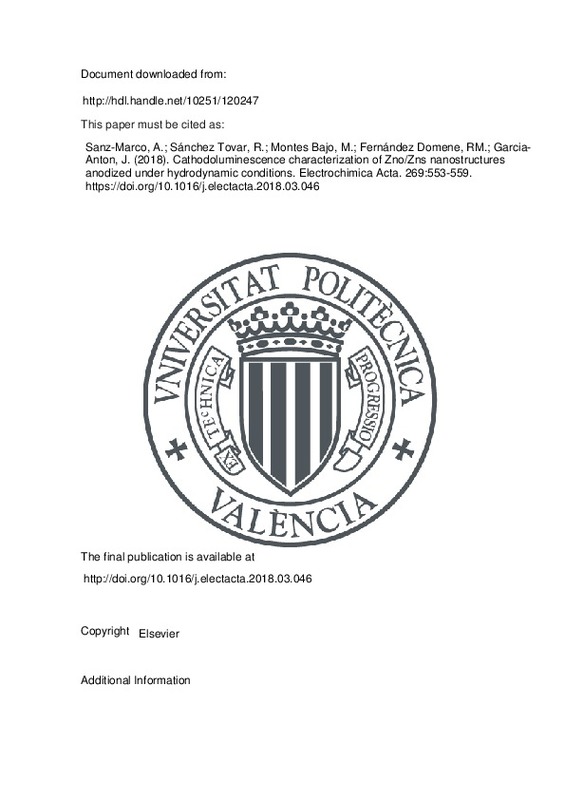JavaScript is disabled for your browser. Some features of this site may not work without it.
Buscar en RiuNet
Listar
Mi cuenta
Estadísticas
Ayuda RiuNet
Admin. UPV
Cathodoluminescence characterization of Zno/Zns nanostructures anodized under hydrodynamic conditions
Mostrar el registro sencillo del ítem
Ficheros en el ítem
| dc.contributor.author | Sanz-Marco, Arturo
|
es_ES |
| dc.contributor.author | Sánchez Tovar, Rita
|
es_ES |
| dc.contributor.author | Montes Bajo, Miguel
|
es_ES |
| dc.contributor.author | Fernández Domene, Ramón Manuel
|
es_ES |
| dc.contributor.author | Garcia-Anton, Jose
|
es_ES |
| dc.date.accessioned | 2019-05-09T20:28:48Z | |
| dc.date.available | 2019-05-09T20:28:48Z | |
| dc.date.issued | 2018 | es_ES |
| dc.identifier.issn | 0013-4686 | es_ES |
| dc.identifier.uri | http://hdl.handle.net/10251/120247 | |
| dc.description.abstract | [EN] ZnO/ZnS nanostructures were successfully synthesized by a simple electrochemical anodization of zinc in a glycerol based electrolyte containing sulfide-ammonium fluoride. The influence of different hydrodynamic conditions and anodization potentials during anodization on the morphological and electronic properties of the obtained ZnO/ZnS nanostructures was studied. The anodized samples were characterized using confocal Raman microscopy, X-Ray Diffraction (XRD), Field Emission Scanning Electronic Microscopy (FE-SEM), cathodoluminescence (CL), and photoelectrochemical water splitting tests under standard AM 1.5 conditions. The results showed that hydrodynamic conditions and higher potentials promoted the formation of ZnO/ZnS nanotubes with both higher sulphur content and crystalline defect density, which reduces the near band edge transition value of the materials and improves the photoelectrochemical activity for water splitting. Additionally, the higher photocurrent densities for water splitting were obtained for the samples anodized at the highest anodization potential and under hydrodynamic conditions, increasing in a 71% for the nanostructures anodized at 1000 rpm when the anodization potential changes from 20 to 40 V. (c) 2018 Elsevier Ltd. All rights reserved. | es_ES |
| dc.description.sponsorship | Authors thank to the financial support to the Ministerio de Economia y CompetitividadMinisterio de Economia y Competitividad (Project code: CTQ2016-79203-R) and for the co-finance by the European Social Fund and to Dr. Luis Villaescusa Alonso for providing technical support with the XRD. | es_ES |
| dc.language | Inglés | es_ES |
| dc.publisher | Elsevier | es_ES |
| dc.relation.ispartof | Electrochimica Acta | es_ES |
| dc.rights | Reconocimiento - No comercial - Sin obra derivada (by-nc-nd) | es_ES |
| dc.subject | Anodization | es_ES |
| dc.subject | Cathodoluminescence | es_ES |
| dc.subject | Photocatalyst | es_ES |
| dc.subject | Water splitting | es_ES |
| dc.subject | ZnO/ZnS nanostructure | es_ES |
| dc.subject.classification | INGENIERIA QUIMICA | es_ES |
| dc.title | Cathodoluminescence characterization of Zno/Zns nanostructures anodized under hydrodynamic conditions | es_ES |
| dc.type | Artículo | es_ES |
| dc.identifier.doi | 10.1016/j.electacta.2018.03.046 | es_ES |
| dc.relation.projectID | info:eu-repo/grantAgreement/MINECO//CTQ2016-79203-R/ES/MODIFICACION DE FOTOCATALIZADORES DE OXIDOS METALICOS NANOESTRUCTURADOS PARA LA ELIMINACION DE FARMACOS Y PRODUCCION ENERGETICA/ | es_ES |
| dc.rights.accessRights | Abierto | es_ES |
| dc.contributor.affiliation | Universitat Politècnica de València. Departamento de Ingeniería Química y Nuclear - Departament d'Enginyeria Química i Nuclear | es_ES |
| dc.description.bibliographicCitation | Sanz-Marco, A.; Sánchez Tovar, R.; Montes Bajo, M.; Fernández Domene, RM.; Garcia-Anton, J. (2018). Cathodoluminescence characterization of Zno/Zns nanostructures anodized under hydrodynamic conditions. Electrochimica Acta. 269:553-559. https://doi.org/10.1016/j.electacta.2018.03.046 | es_ES |
| dc.description.accrualMethod | S | es_ES |
| dc.relation.publisherversion | http://doi.org/10.1016/j.electacta.2018.03.046 | es_ES |
| dc.description.upvformatpinicio | 553 | es_ES |
| dc.description.upvformatpfin | 559 | es_ES |
| dc.type.version | info:eu-repo/semantics/publishedVersion | es_ES |
| dc.description.volume | 269 | es_ES |
| dc.relation.pasarela | S\378176 | es_ES |
| dc.contributor.funder | Ministerio de Economía y Competitividad | es_ES |







![[Cerrado]](/themes/UPV/images/candado.png)

